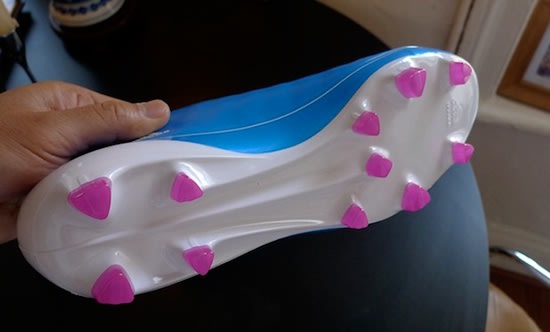 According to Adidas's senior product manager, Aubrey Dolan, there's actually a slew of high-tech breakthroughs at work. "You can always remove materials to make one lightweight sample, but mass-producing something for a mass market that actually functions is another challenge entirely."
According to Adidas's senior product manager, Aubrey Dolan, there's actually a slew of high-tech breakthroughs at work. "You can always remove materials to make one lightweight sample, but mass-producing something for a mass market that actually functions is another challenge entirely."Almost all soccer shoes have a stiff insole board that keeps them stable. The F50 Adizero doesn't have that at all--instead it simply has a molded poly-amide outsole they call a "sprint frame." All the stability comes from the fins running across the middle of the footprint:
These, in turn, are molded in carefully calibrated, organic shapes--if there were any sharp angles, the sole could actually snap since it is, after all, just a thin slip of high-tech plastic. Variations in the shape and thickness of the frame--and the placement of the curving ribs--allows flexibility in some places, such as the forefoot, and rigidity in the heel:
According to Dolan, the inspiration was modern-day cycling. "In the bike frames you see in the Tour de France, all the strength comes from the geometry itself."
And the upper of the shoe, which just seems like plastic-y sheath, hides an intense process of materials engineering. It's made of microfiber--that is, synthetic fibers that have be intertwined, which allowed the materials engineers to dial in a precise combination of flex and rigidity. That way, you don't have to add more material to create interior supports, and you can even print additional support structures directly onto the shoe, which isn't possible with your standard leather:

But what insures that these race cars won't fly apart when they're actually in use? "It's safe to say this is the most rigorously tested product we've ever made," says Dolan. The shoes were put through paces on myriad players--pros and amateurs alike--and the even tested in cold rooms and hot rooms, to ensure they wouldn't break down.


